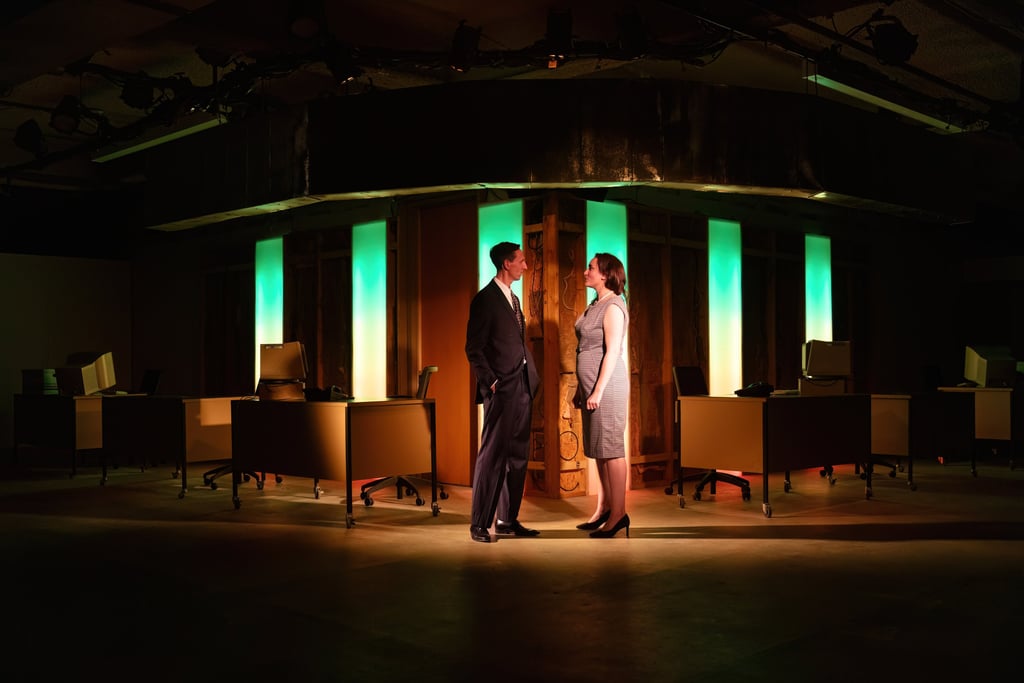Enron Takes Corporate Scandal to a Downtown Skyscraper
Surrounded by the glass tower that collides with the world of the play, the line between past, performance, and reality blurs uncomfortably. That’s the brilliance, and the warning of this production.
Mingsi Ma
11/12/20254 min read


Promotional photo of Quantum Theatre’s Enron. Photo courtesy of Jason Snyder.
By Mingsi Ma
Let’s put it this way: we all know that Quantum Theatre is famous for not having a home venue, instead adopting the outside-of-the-box approach as their mission, venturing out to different venues with each production. This time, setting the Pittsburgh Premiere of the British playwright Lucy Prebble’s Enron at One Oxford Centre is brilliant. Occupied by prestigious law firms, banks, and finance companies, this high-rise skyscraper has already laid the groundwork for the story before we even see the lights come up. Behind its gleaming glass windows stretch rows of identical “modern” offices, each filled with the same dull, homogeneous look and black-white-and-gray furniture. Enron, once one of the largest companies in the U.S. at its peak, is forever remembered for its massive corporate accounting scandal at the turn of the century.
Enron depicts the rise and fall of the company under the leadership of CEO Jeffrey Skilling, CFO Andy Fastow, and former CEO Ken Lay. Drawing on the real scandal, Lucy Prebble makes intricate financial schemes that took years of FBI investigation before the jury’s conviction easy to understand through vivid metaphors. The narrative unfolds step by step, revealing the escalating depth of financial fraud and corporate greed. With the thrilling storytelling, even those unfamiliar with the corporate world would find the play captivating.


Joseph McGranaghan as Jeffrey Skilling and Christine Weber as Claudia Roe. Photo courtesy of Beth Barbis.
What Quantum transformed into the stage appears to be a bare-shell office. Scenic designer Sasha Jin Schwartz takes advantage of the space and constructs a V-shaped stage, matched by audience seating that mirrors the same angular design. The space is set up with two sets of conference tables on each side of the V and resembles the corporate office. The warm yellow lights bring the nostalgia that belongs to the 90s. The shape of the stage adds depth, allowing the actors to move dynamically from one end to the other and making the unfolding of each scene feel more layered. It’s also an organic and impressive design that creates an immersive and intimate experience through the stage’s interaction with the building and the proximity between the audience and the actors.


Traders at the office. Photo courtesy of Beth Barbis.
The collaboration between Quantum and Attack Theatre is hugely successful, bringing joy, dazzle, and energy to the performance, irresistible like those cheerfully colorful sprinkles on a cupcake. Directed by Kyle Haden, choreographed by Michele de la Reza and Peter Kope, the performance is well-paced by a powerful mix of dialogue, media, dance, kinetic movement, and even puppetry. As traders dash across the office, chairs spin, keyboards chatter, and voices collide over phone calls, the dancers and actors use the choreographed chaos to capture the wild, unregulated expansion of Enron’s energy trading empire. The dancers also jump on the office desk and touch the ceiling, mimicking an old Enron ad that touts how the company is creating an “open, transparent marketplace” and “trying to change the world”. This clever reference to Enron’s original marketing campaign adds sarcasm that exposes the dark hypocrisy of the company.
We can’t talk about Enron’s staggering corporate fraud without mentioning Jeffrey Skilling, the play’s lead character and the man who received the longest sentence in the case. He was initially sentenced to 24 years in prison. Played by Joseph McGranaghan, Skilling is intoxicated with his ego and a ruthless belief in Darwinism that glorifies self-interest and competition. McGranaghan’s Skilling comes across as business-savvy, exuding a “fake it till you make it” bravado along with manic energy. His confidence jumps between bravado and hysteria, making the character feel restless.
McGranaghan’s performance is engaging and entertaining, though the portrayal could benefit from additional nuance. When talking to employees and addressing the public, Skilling might demand absolute calm, confidence, and dominance to secure the trust and unreserved support. In private, such as revealing Enron’s looming crisis to the CFO-to-be Andy Fastow, one could imagine more manipulation, exploiting Andy’s desire to climb up the corporate ladder. And as the downfall accelerates, an increasing sense of anxiety and loss of control could intensify the scope of the scandal. As the story unfolds, it presents an opportunity for greater psychological shading instead of a relatively consistent presence.
When the lights finally come up, I walk toward the elevator, passing the rest of the bare-shell office scattered with office desks and chairs. I can’t help but imagine the last day at bankrupt Enron: employees frustratedly packing up their belongings, leaving their workplace that was once one of the country’s most promising companies, only to face the scary unknown and their vanished retirement funds. Surrounded by the glass tower that collides with the world of the play, the line between past, performance, and reality blurs uncomfortably. That’s the brilliance, and the warning of this production.
Quantum Theatre’s Enron is presented in association with Attack Theatre. It is now on stage through Sunday, November 23, 2025, at One Oxford Centre, Downtown Pittsburgh.